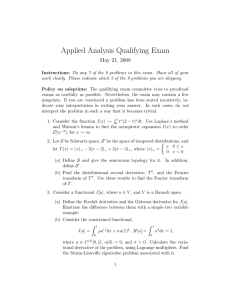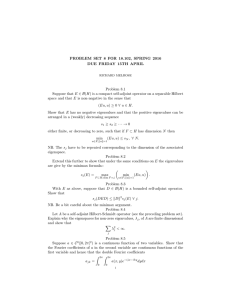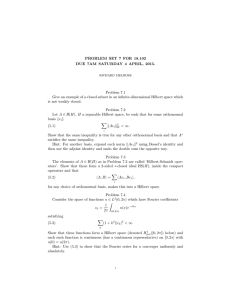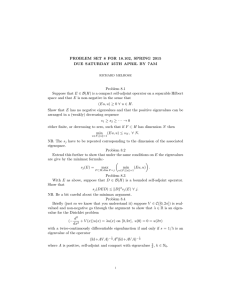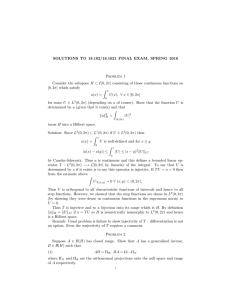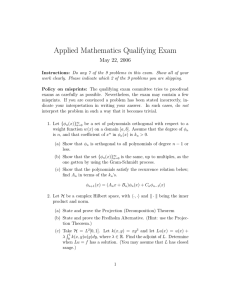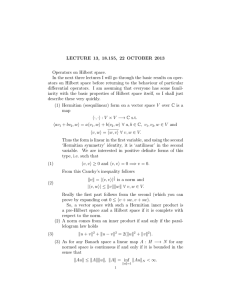18.102 QUESTIONS FOR FINAL EXAM, SPRING 2015 Problem 1 −→ H
advertisement
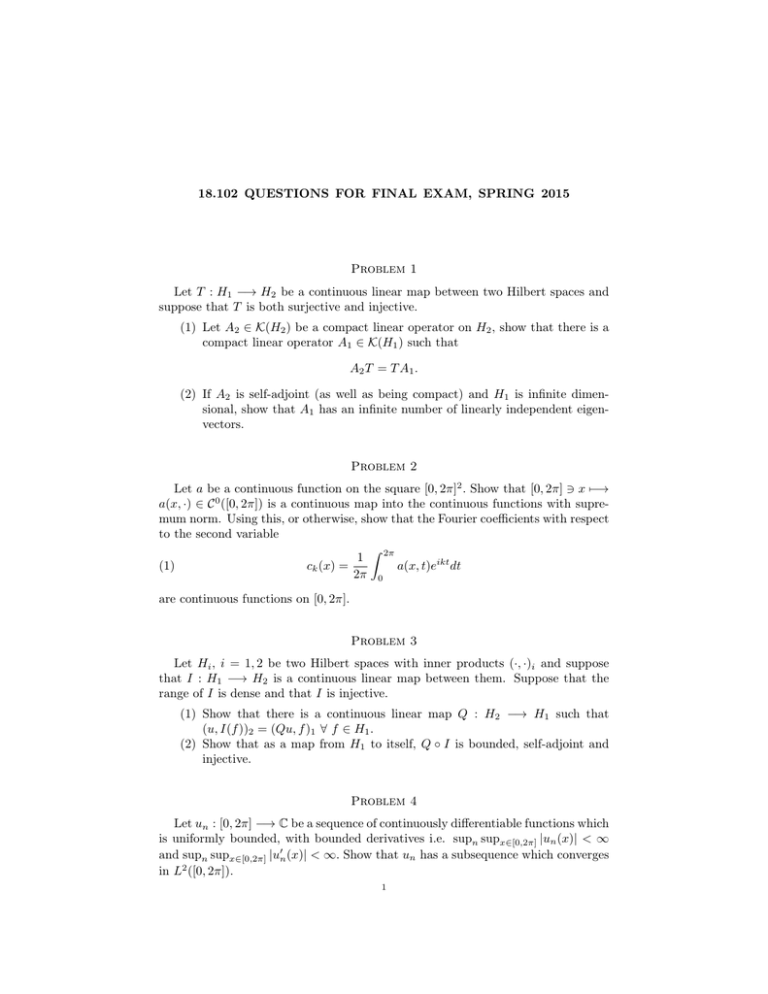
18.102 QUESTIONS FOR FINAL EXAM, SPRING 2015
Problem 1
Let T : H1 −→ H2 be a continuous linear map between two Hilbert spaces and
suppose that T is both surjective and injective.
(1) Let A2 ∈ K(H2 ) be a compact linear operator on H2 , show that there is a
compact linear operator A1 ∈ K(H1 ) such that
A2 T = T A1 .
(2) If A2 is self-adjoint (as well as being compact) and H1 is infinite dimensional, show that A1 has an infinite number of linearly independent eigenvectors.
Problem 2
Let a be a continuous function on the square [0, 2π]2 . Show that [0, 2π] 3 x 7−→
a(x, ·) ∈ C 0 ([0, 2π]) is a continuous map into the continuous functions with supremum norm. Using this, or otherwise, show that the Fourier coefficients with respect
to the second variable
Z 2π
1
a(x, t)eikt dt
(1)
ck (x) =
2π 0
are continuous functions on [0, 2π].
Problem 3
Let Hi , i = 1, 2 be two Hilbert spaces with inner products (·, ·)i and suppose
that I : H1 −→ H2 is a continuous linear map between them. Suppose that the
range of I is dense and that I is injective.
(1) Show that there is a continuous linear map Q : H2 −→ H1 such that
(u, I(f ))2 = (Qu, f )1 ∀ f ∈ H1 .
(2) Show that as a map from H1 to itself, Q ◦ I is bounded, self-adjoint and
injective.
Problem 4
Let un : [0, 2π] −→ C be a sequence of continuously differentiable functions which
is uniformly bounded, with bounded derivatives i.e. supn supx∈[0,2π] |un (x)| < ∞
and supn supx∈[0,2π] |u0n (x)| < ∞. Show that un has a subsequence which converges
in L2 ([0, 2π]).
1
2
18.102 QUESTIONS FOR FINAL EXAM, SPRING 2015
Problem 5
Consider the subspace H ⊂ C[0, 2π] consisting of those continuous functions on
[0, 2π] which satisfy
Z x
(2)
u(x) =
U (x), ∀ x ∈ [0, 2π]
0
2
for some U ∈ L (0, 2π) (depending on u of course). Show that the function U is
determined by u (given that it exists) and that
Z
2
(3)
kukH =
|U |2
(0,2π)
turns H into a Hilbert space.
Problem 6
Consider the space of those complex-valued functions on [0, 1] for which there is
a constant C (depending on the function) such that
1
|u(x) − u(y)| ≤ C|x − y| 2 ∀ x, y ∈ [0, 1].
(4)
Show that this is a Banach space with norm
kuk 12 = sup |u(x)| +
(5)
[0,1]
inf
C.
(4) holds
Problem 7
Let Aj ⊂ R be a sequence of subsets with the property that the characteristic
function, χj of Aj ,Sis integrable for each j. Show that the characteristic function of
R \ A, where A = j Aj is locally integrable.
Problem 8
Let A be a Hilbert-Schmidt operator on a separable Hilbert space H, which
means that for some orthonormal basis {ei }
X
(6)
kAei k2 < ∞.
i
Using Bessel’s identity
kAei k2 with respect to another orthonormal baP to∗ expand
P
2
sis {fj } show that
kA fj k =
kAei k2 . Conclude that the sum in (6) is indej
i
pendent of the othornormal basis used to define it and that the Hilbert-Schmidt
operators form a Hilbert space.
Problem 9
Let Bn be a sequence of bounded linear operators on a Hilbert space H such
that for each u and v ∈ H the sequence (Bn u, v) converges in C. Show that there
is a uniquely defined bounded operator B on H such that
(Bu, v) = lim (Bn u, v) ∀ u, v ∈ H.
n→∞
18.102 QUESTIONS FOR FINAL EXAM, SPRING 2015
3
Problem 10
Suppose P ⊂ H is a closed linear subspace of a Hilbert space, with πP : H −→ P
the orthogonal projection onto P. If H is separable and A is a compact self-adjoint
operator on H, show that there is a complete orthonormal basis of H each element
of which satisfies πP AπP ei = ti ei for some ti ∈ R.
Problem 11
j −x2 /2
d
Let ej = cj C e
, cj > 0, where j = 1, 2, . . . , and C = − dx
+ x is the
2
creation operator, be the orthonormal basis of L (R) consisting of the eigenfunctions
of the harmonic oscillator discussed in class. You may assume completeness in
d2 e
L2 (R) and use the facts established in class that − dx2j + x2 ej = (2j + 1)ej , that
1
1
cj = 2−j/2 (j!)− 2 π − 4 and that ej = pj (x)e0 for a polynomial of degree j. Compute
Cej and Aej in terms of the basis and hence arrive at a formula for dej /dx. Use
1 de
this to show that the sequence j − 2 dxj is bounded in L2 (R). Conclude that if
X
1
(7)
Hiso
= {u ∈ L2 (R);
j|(u, ej )|2 < ∞}
j≥1
1
then there is a uniquely defined operator D : Hiso
−→ L2 (R) such that Dej =
for each j.
dej
dx
Problem 12
R
Suppose that f ∈ L (0, 2π) is such that the constants ck = (0,2π) f (x)e−ikx , k ∈
P
Z, satisfy
|ck |2 < ∞. Show that there is an element g ∈ L2 ([0, 2π]) such that
k∈Z
R
(f − g)eikx dx = 0 for all k ∈ Z.
1
Problem 13
Let A be a compact self-adjoint operator on a separable Hilbert space and suppose that for any orthonormal basis
X
(8)
|(Aei , ei )| < ∞.
i
Show that the eigenvalues of A, if infinite in number, form a sequence in l1 .
Problem 14
For u ∈ L2 (0, 1) show that
Z
x
u(t)dt, x ∈ (0, 1)
Iu(x) =
0
is a bounded linear operator on L2 (0, 1). If V ∈ C([0, 1]), is real-valued and V ≥ 0,
show that there is a bounded linear operator B on L2 (0, 1) such that
(9)
B 2 u = u + I ∗ MV Iu ∀ u ∈ L2 (0, 1)
where MV denotes multiplication by V.

